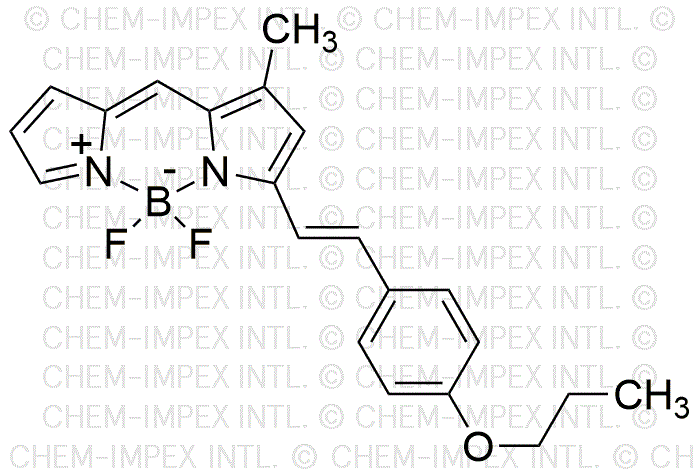4,4-Difluoro-1-methyl-3-(4-propoxystyryl)-4-bora-3a,4a-diaza-s-indacene is widely utilized in research focused on:
- Fluorescent Probes: This compound serves as a highly effective fluorescent probe in biological imaging, allowing researchers to visualize cellular processes in real-time.
- Organic Light Emitting Diodes (OLEDs): Its unique optical properties make it suitable for use in OLEDs, enhancing the efficiency and color purity of displays.
- Photodynamic Therapy: In the medical field, it can be applied in photodynamic therapy for cancer treatment, where its fluorescence can help target and destroy cancer cells.
- Sensor Technology: The compound is used in developing sensors for detecting environmental pollutants due to its sensitivity to specific chemical changes.
- Research and Development: It is a valuable tool in materials science for synthesizing new materials with tailored optical properties, aiding in the advancement of nanotechnology.
General Information
Properties
Safety and Regulations
Applications
4,4-Difluoro-1-methyl-3-(4-propoxystyryl)-4-bora-3a,4a-diaza-s-indacene is widely utilized in research focused on:
- Fluorescent Probes: This compound serves as a highly effective fluorescent probe in biological imaging, allowing researchers to visualize cellular processes in real-time.
- Organic Light Emitting Diodes (OLEDs): Its unique optical properties make it suitable for use in OLEDs, enhancing the efficiency and color purity of displays.
- Photodynamic Therapy: In the medical field, it can be applied in photodynamic therapy for cancer treatment, where its fluorescence can help target and destroy cancer cells.
- Sensor Technology: The compound is used in developing sensors for detecting environmental pollutants due to its sensitivity to specific chemical changes.
- Research and Development: It is a valuable tool in materials science for synthesizing new materials with tailored optical properties, aiding in the advancement of nanotechnology.
Documents
Safety Data Sheets (SDS)
The SDS provides comprehensive safety information on handling, storage, and disposal of the product.
Product Specification (PS)
The PS provides a comprehensive breakdown of the product’s properties, including chemical composition, physical state, purity, and storage requirements. It also details acceptable quality ranges and the product's intended applications.
Certificates of Analysis (COA)
Search for Certificates of Analysis (COA) by entering the products Lot Number. Lot and Batch Numbers can be found on a product’s label following the words ‘Lot’ or ‘Batch’.
*Catalog Number
*Lot Number
Certificates Of Origin (COO)
This COO confirms the country where the product was manufactured, and also details the materials and components used in it and whether it is derived from natural, synthetic, or other specific sources. This certificate may be required for customs, trade, and regulatory compliance.
*Catalog Number
*Lot Number
Safety Data Sheets (SDS)
The SDS provides comprehensive safety information on handling, storage, and disposal of the product.
DownloadProduct Specification (PS)
The PS provides a comprehensive breakdown of the product’s properties, including chemical composition, physical state, purity, and storage requirements. It also details acceptable quality ranges and the product's intended applications.
DownloadCertificates of Analysis (COA)
Search for Certificates of Analysis (COA) by entering the products Lot Number. Lot and Batch Numbers can be found on a product’s label following the words ‘Lot’ or ‘Batch’.
*Catalog Number
*Lot Number
Certificates Of Origin (COO)
This COO confirms the country where the product was manufactured, and also details the materials and components used in it and whether it is derived from natural, synthetic, or other specific sources. This certificate may be required for customs, trade, and regulatory compliance.


